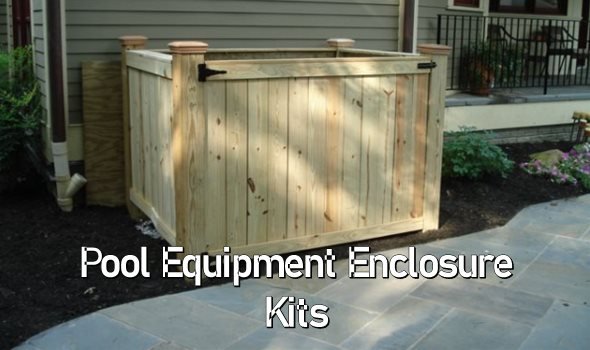Many pool owners face the challenge of unsightly equipment ruining their backyard’s look. Exposed pipes, filters, and pumps are an eyesore that spoils the pool area’s beauty. They make your outdoor space look messy and unfinished.

Pool equipment enclosure kits are the perfect fix for this issue. They offer a stylish way to hide these systems while protecting your equipment from the weather. By hiding these elements, you can turn your pool area into a sleek, professional-looking space. This enhances your property’s overall look.
Understanding Pool Equipment Visibility Challenges
Swimming pool design often faces challenges with visible equipment. Exposed pipes, filters, and pumps can ruin the look of a backyard. They turn a peaceful area into a messy mechanical zone.

Read also: How Much Bleach to Add to Pool to Make Swimming Safe?
Common Aesthetic Issues with Exposed Equipment
Visible pool equipment can ruin the look of your outdoor space. The industrial look of pumps, filters, and pipes clashes with landscaped yards and pool designs. Homeowners often face issues with:
- Unattractive metal and plastic components
- Cluttered and unorganized equipment areas
- Mechanical elements that disrupt the pool’s natural look
Impact on Property Value and Curb Appeal
Buyers and visitors judge a property by its exterior. An equipment enclosure can boost your pool’s look, raising property value. Hidden equipment makes your outdoor space look better, attracting buyers.
Safety Considerations for Exposed Pool Equipment
Exposed equipment is not just ugly; it’s also a safety risk. It can harm children and pets, making your backyard unsafe. An enclosure offers:
- Protection from accidental contact
- Reduced risk of equipment tampering
- Enhanced overall safety for your outdoor living space
Types of Pool Equipment Enclosure Kits Available
Choosing the right pool equipment enclosure can make your backyard look better and keep your pool equipment safe. I’ve looked at many pool equipment enclosure options. They meet different needs and tastes.
There are several types of pool equipment enclosure kits available. Each has its own benefits:
- Pre-fabricated metal enclosures
- Wooden panel kits
- Modular plastic solutions
- Custom-designed aluminum structures
- Decorative brick and stone enclosures
Pre-fabricated kits are the easiest to install. They come in various sizes and include everything you need to set them up.
Custom solutions give you the most flexibility. Experts can create enclosures that fit your equipment and landscape perfectly.
When picking a pool equipment enclosure kit, think about durability, ventilation, and how easy it is to get to your equipment. Also, make sure it looks good with your outdoor space. Each type of enclosure has its own advantages for keeping your pool equipment safe and hidden.
Read also: Role Water Chemistry of Alkalinity VS PH in Swimming Pool?
Material Options for Equipment Covers
Choosing the right material for your pool equipment enclosure kits is key. It helps protect and hide your pool equipment well. Each material has its own benefits and challenges, so it’s important to know your options.
Homeowners need to think about durability, upkeep, looks, and the local weather when picking materials. Each option has its own strengths that can affect how well your enclosure works and lasts.
Read also: How to Find a Leak in an Above Ground Pool in Vinyl Liner Material
Aluminum and Metal Solutions
Metal enclosures are strong and last a long time. Aluminum is a great choice because it’s light and doesn’t rust. These enclosures can handle tough weather and look modern.
- Rust-resistant properties
- Lightweight design
- Minimal maintenance requirements
- Professional aesthetic appeal
Wood and Composite Materials
Wooden enclosures have a natural look that fits well with outdoor designs. Composite materials are even more durable than wood, helping avoid rot and weather damage.
| Material | Durability | Maintenance | Cost |
|---|---|---|---|
| Cedar Wood | Moderate | High | Medium |
| Composite | High | Low | High |
PVC and Plastic Alternatives
PVC and plastic enclosures are affordable for those looking for a budget-friendly option. They’re water-resistant, need little upkeep, and can be colored to match your outdoor decor.
- Cost-effective options
- Weather-resistant
- Lightweight installation
- Multiple color choices
DIY vs Pre-Made Pool Equipment Enclosure Kits
Choosing between DIY and pre-made pool equipment enclosure kits can be tough. Homeowners want to hide their pool equipment well. Each choice has its own benefits that can affect your project’s success and how happy you’ll be with it.
DIY kits let you customize a lot. You can make an enclosure that fits your yard and pool equipment perfectly. This option is cheaper but takes more time and skill.
- Lower initial investment
- Complete design control
- Opportunity for personal creativity
- Potential cost savings
Pre-made kits are convenient and offer top-notch solutions. They come with exact sizes, professional designs, and quick setup. They might cost more but save a lot of time and effort.
- Quick installation
- Professional manufacturing
- Consistent quality
- Reduced labor requirements
When picking between DIY and pre-made kits, think about your budget, skills, time, and what you want to look like. Both ways can hide your pool equipment well and make your outdoor space look better.
Measuring and Planning Your Enclosure Space
When designing equipment enclosure kits for your swimming pool, getting the measurements right is key. My experience shows that precision is vital for your pool equipment space to work well.
Read also: How Much Bleach to Add to Pool to Make Swimming Safe?
Proper planning is essential for your equipment enclosure to fit perfectly with your pool setup.
Required Clearances for Optimal Performance
Equipment enclosure kits need specific space to perform at their best. Here are some important guidelines to follow:
- Maintain minimum 12-18 inches of clearance around pool equipment
- Ensure unobstructed access for maintenance and repairs
- Allow adequate space for ventilation and heat dissipation
Strategic Equipment Access Considerations
Accessibility is critical when designing your swimming pool equipment enclosure. Think about future maintenance needs and service requirements. Make sure technicians can easily check and fix pool systems without taking apart the whole enclosure.
Key access strategies include:
- Removable panels or doors
- Hinged sections for quick equipment checks
- Modular design that permits component replacement
By carefully measuring and planning your equipment enclosure space, you’ll protect your swimming pool investments. You’ll also keep your outdoor area looking great.
Custom Built Solutions for Pool Equipment

Creating a custom pool equipment enclosure can turn an ugly space into a beautiful feature. It can hide your pool’s pipes and filters while matching your yard’s look.
When designing a custom solution, think about a few important things:
- Precise measurements of your pool equipment layout
- Local building codes and ventilation requirements
- Aesthetic harmony with your property’s design
- Materials that withstand outdoor conditions
Professional designers have many ways to hide your pool’s equipment. Some popular options include:
- Brick or stone wall enclosures with decorative elements
- Aluminum framed structures with lockable access panels
- Wooden pergola-style covers with integrated screening
- Modern minimalist metal box designs
Getting a custom pool equipment enclosure does more than just look good. It also keeps your equipment safe from the weather. With a pro designer, you can find a solution that looks great and works well.
Installing Pool Equipment Enclosure Kits
Installing pool equipment enclosure kits can change your outdoor space’s look. It also protects your pool’s important parts. I’ll show you how to cover your pool equipment and make your pool area look better.
Preparation and Planning
Before starting, you need to prepare well. Take exact measurements of your pool equipment area. Then, pick enclosure kits that fit your space and equipment layout.
- Measure pool equipment dimensions accurately
- Check manufacturer specifications for clearance requirements
- Verify local building codes and regulations
Required Tools and Materials
To install enclosure kits right, you need the right tools and materials. Here’s a list to help you get ready:
| Tools | Materials |
|---|---|
| Power drill | Mounting brackets |
| Level | Screws and anchors |
| Measuring tape | Sealant |
| Hammer | Protective cover panels |
Installation Steps
- Clear the installation area of debris
- Mark mounting points using a level
- Install mounting brackets securely
- Attach enclosure panels
- Apply sealant for weather protection
- Verify proper ventilation for pool equipment
By following these steps, you’ll have a professional-looking enclosure. It will protect your pool equipment and make your outdoor area look great. Don’t forget to make sure there’s good ventilation and easy access for maintenance.
Maintenance Access and Serviceability Features
When designing a pool equipment enclosure, it’s key to think about maintenance access. The best enclosures make it easy to keep your pool system in top shape. This makes routine upkeep and repairs a breeze for pool owners.
Design features can really change how you deal with pool equipment. Features like removable panels and hinged doors are huge. They let you get to important parts of the equipment quickly and easily.
- Removable side panels for direct equipment access
- Hinged doors with secure latching mechanisms
- Ventilated design to prevent equipment overheating
- Modular construction for flexible maintenance
Pool equipment enclosures should do more than look good. They need to be practical. Look for enclosures with many access points. This way, every important part of your pool system is easy to get to.
This approach makes maintenance simpler and keeps your equipment safe from damage. When you’re looking for an enclosure, focus on designs that offer full access. Your future self will appreciate it for making maintenance easy and worry-free.
Cost Comparison of Different Enclosure Options
When planning a swimming pool equipment enclosure, it’s key to know the costs. Enclosure kits vary from affordable to high-end. I found many options that fit different budgets and tastes.
Pricing for pool equipment enclosures usually falls into three main categories:
- Budget-Friendly DIY Solutions ($50-$300)
- Mid-Range Prefabricated Kits ($300-$800)
- Premium Custom Enclosures ($800-$2,500)
Budget-Friendly Solutions
For those on a tight budget, basic enclosure kits are a good choice. Vinyl and lightweight plastic enclosures are cheap but effective. They keep your pool area clean and safe.
Premium Enclosure Investments
High-end enclosures offer better durability and style. Aluminum and custom wooden structures provide top-notch protection. They also boost your property’s look. These options might cost more but last longer and add value.
| Enclosure Type | Price Range | Durability |
|---|---|---|
| Plastic Kit | $50-$300 | Low |
| Aluminum Frame | $500-$1,500 | High |
| Custom Wood | $1,000-$2,500 | Very High |
Choosing the right enclosure depends on your needs, budget, and style goals for your pool area.
Incorporating Enclosures into Landscape Design

Adding a pool equipment enclosure to your landscape makes it look better. It turns something useful into something beautiful. By planning well, you can make these structures fit right in with your outdoor space.
Here are some ideas for designing equipment enclosure kits:
- Match surrounding architectural elements and color schemes
- Use complementary materials like wood or stone
- Incorporate decorative plantings around the pool equipment enclosure
- Create multi-functional screening solutions
Choose materials that fit with your landscape. Wooden enclosures can look like garden fences. Stone-textured covers can match rock gardens or hardscape features. This way, your pool equipment enclosure looks like it was meant to be there.
Smart landscaping tricks can hide equipment enclosures. Ornamental grasses, climbing plants, or small shrubs can soften the look. Some people even turn enclosures into vertical gardens, adding greenery and interest to blank spots.
But remember, ventilation and access to equipment are key. Make sure your creative ideas don’t mess with how your pool works.
Weather Protection and Durability Considerations
Keeping your pool equipment safe is key to its long life and good work. When picking an enclosure, knowing about weather challenges is important. Different places have their own weather needs that affect your equipment’s strength.
Weather protection is more than just covering things up. Pool equipment enclosures must handle many weather stresses. These stresses can harm their structure and how well they work.
Climate-Specific Solutions
Every area needs its own special ways to protect pool equipment. My advice is to use targeted methods:
- Coastal Areas: Use materials that resist saltwater and corrosion well.
- Humid Regions: Choose enclosures that breathe and resist moisture.
- Extreme Temperature Zones: Pick covers that keep temperature steady.
Long-Term Maintenance Requirements
Keeping your pool equipment enclosure in good shape is vital. Regular checks and early action are key.
| Maintenance Task | Frequency | Purpose |
|---|---|---|
| Cleaning Exterior | Quarterly | Remove debris, prevent material degradation |
| Seal Inspection | Bi-Annually | Check weatherproofing integrity |
| Hardware Lubrication | Annually | Ensure smooth operation of moving parts |
With these steps, you can keep your equipment safe and working well, no matter the weather.
Conclusion
Buying pool equipment enclosure kits can make your swimming pool area look better and work better. These kits hide pipes, filters, and other parts, making your outdoor space look nicer.
Choosing the right kit can protect your pool from the weather, cut down on noise, and make your yard look better. There are many materials and styles to pick from. You can find one that fits your home and your taste.
Investing in a good enclosure can make your property look better and even increase its value. You can do it yourself or hire a pro. Either way, it’s a smart choice for your pool’s future.
Make sure to plan well, measure right, and think about your local weather. This will help you pick the best enclosure for your needs. Your outdoor space should look great and work well.


